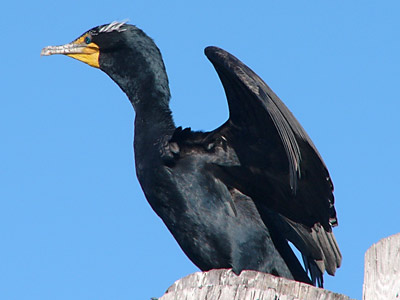Double-crested Cormorant

Common Name: Double-crested Cormorant
Scientific Name: Phalacrocorax auritus
Description
Double-crested Cormorants are part of a world-wide order of seabirds that includes pelicans, boobies, tropicbirds, and frigatebirds. They are members of the family Phalacrocoracidae and can be found throughout North America in both fresh water and marine habitats. Double-crested, Red-faced, and Pelagic cormorants are the only cormorants found in Alaska. Cormorants dive underwater and use their large webbed feet as paddles to swim in search of food.
Unlike other seabirds, cormorants do not venture far from their nesting colony. They build tall, stacked nests out of whatever plant material they can find and are not above stealing it from one of their unsuspecting neighbors. Often, one bird of the pair will present a piece of grass or seaweed to its mate as a way of strengthening their bond.
Diet
They eat a wide variety of foods, but fish that live close to the ocean floor are their favorites.
Characteristics
All black feathers on entire body except for yellow bill. Thick neck with hooked bill.
Size
Height:70-90 cm (28-35 in);
Weight: 1200-2500 g (42.36-88.25 ounces);
Life History
This bird forages for fish, mostly by diving and being able to stay underwater for about 30 seconds. It tends to rest and roost on offshore cliffs and on rocks, wharfs, and branches. It sometimes rests on water. Its takeoff is quite laborious. The nests are quite sensitive to disturbance and are found on rocky cliffs, slopes, and tall trees. Breeding season runs from April to August. This species is monogamous by nature and nests colonially.
Frequency
The Double-crested Cormorantis common throughout the year within the Presidio.
Identifying Characteristics
This bird has the tendency to be an upright percher with a S-shaped neck and hook-tipped bill. Unlike its relative, the Brandt's Cormorant, this species displays an orange-yellow throat pouch. These birds tend to cluster in silent flocks, forming in geese-like patterns.
Distribution
Unlike the Pelagic and Red-faced cormorants, Double-crested's are the least picky about where they build their nests, finding comfortable spots Double-crested commoranton vertical cliff faces, flat ground, and even in trees. Their nests have to be large enough to hold up to four chicks, who grow as large as their parents before they leave the nest for good. Before the young cormorants fledge, they wander from their nest to socialize with other young cormorants in groups called creches.
For most of the year, cormorants wear a rather dull plumage. When the breeding season approaches they dress -up in their best outfits in hopes of attracting a mate. Their dusty gray-black feathers take on an iridescence like that of pea-cock feathers, although not quite as fancy. Depending on the light, their dazzling plumage can look blue, green, purple, black, brown or all of these at once. Double-crested Cormorants grow long white tufts over their eyes before the breeding season, and the skin around their bill and on their throat turns bright Double-crested comorant yellow. Cormorant feathers are unique compared to other diving birds in that they are not naturally waterproof. As a result, they spend a great deal of time spreading oil from a gland at the base of their tail over their feathers to help keep themselves dry and warm.
 Deep Sea Crabs
Deep Sea Crabs